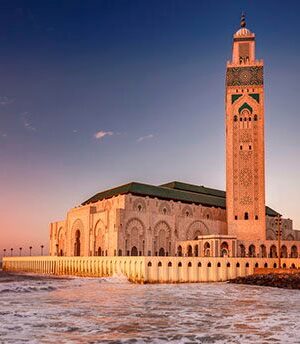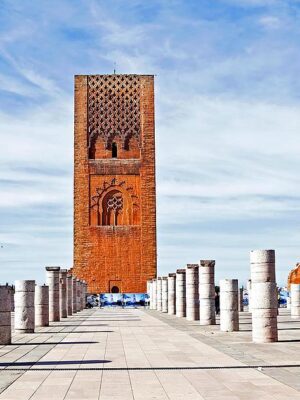Samlpe Itineraries
- Honeymoon in Morocco
- Tour Morocco on Your Way
- Jewish Heritage Tours – 9 Days Tour To Discover the Jewish Heritage
- 8 Days Tour Kingdom of Morocco
- AROUND MOROCCO TRIP In 9 Days
- Authentic Southern Morocco Itinerary
- Highlight Of Morocco Itinerary In 14 Days
- Imperial Cities Trip In 9 Days tour – 9 Days Tour To Discover the Jewish Heritage
- Sahara Highlight Trip From Marrakech
- Customized Tours Of Morocco
Imperial Cities Trip In 9 Days tour – 9 Days Tour To Discover the Jewish Heritage
Day1 – CASABLANCA
Arrive in Casablanca in the morning and meet your driver outside the airport. ‘
○ Begin with a visit to the stunning Hassan II Mosque, the largest in Morocco and the third largest mosque in the world that non-muslims are allowed to enter. Able to accommodate up to 105,000 in prayer, this marvel of modern Moroccan architecture is the work of hundreds of expert craftsmen from around the country, many of them donating their work.
○ Explore Casablanca with a private guide.
○ Visit Casablanca’s Jewish quarter, or Mellah (meaning “salt”, as the Jews were given control over the valuable salt trade by the king), which is still home to temples and synagogues, though it is no longer predominantly inhabited by Jews.
○ Tour the Museum of Moroccan Judaism. The only Jewish museum in the Arab world, the Museum of Moroccan Judaism displays an amazing collection of religious books, costumes, and artifacts reflecting the rich history of the Jewish civilization in Morocco, which dates back over 2,500 years and predates the arrival of the Arabs in the territory.
○ Visit the Habous District. This new medina was built according to the traditional model and is in the south of the city in the Habous neighborhood. You will have a pleasant time admiring its little squares, arcades and numerous craft shops. The mahkama (courthouse) of the Pasha is to be seen here too. This Hispano-Moorish style building, built entirely of marble and wood, has 60 rooms and was used as a courtroom and as a reception room by the ancient Pasha of Casablanca.
○ Overnight in Casablanca.
Day2 – RABAT
○ After breakfast, make your way to Rabat and tour the capitol city with a private guide.
○ Begin with the Hassan Tower, the start of a minaret has sat unfinished for centuries. Abu Yusuf Yaqub al-Mansur began the project in 1195, with the intent to build the largest mosque in the world. However, when the minaret was only half finished at 140 feet, al-Mansur died in 1199 and the project was abandoned.
○ Located opposite the Hassan Tower, the Mohamed V Mausoleum contains the tombs of Mohammed V and his two sons, King Hassan II and Prince Abdallah. Built in 1971, the building is considered a masterpiece of modern Alaouite architecture, with white walls and a green tiled roof. ○ One of the newest mellahs in Morocco, the mellah of Rabat was established in 1808 by Sultan Mawlay Sulaiman. However, by the end of the century, many of the Jews moved out to other neighborhoods.
○ Located in the mellah, the Synagogue Rabbi Shalim Zaoui reflects a Moorish style, with trilobal shapes in the windows, lamps resembling those found in mosques, and ceramic tiles with geometric forms.
○ Surrounded by French-style landscaped gardens, the Royal Palace of Rabat is the residence of the Moroccan royal family. Built in 1864, the palace was designed by French architects inspired by traditional Arabic motifs.
○ Located at the mouth of the Bou Regreg river opposite Sale, the Kasbah Oudaya is adjacent to the Rabat Medina. Dating from the 10th century, the mosque is the oldest building in the Kasbah, and was restored in the 18th century using the funds from an English pirate. The site now includes the famous Andalusian gardens, as well as a residential neighborhood with distinct blue and white walls. ○ Overnight in Rabat
Day 3- Rabat to VOLUBILIS, FES
○ Depart Rabat in the morning to travel to Volubilis.
○ Tour the site with a guide. The site of the ancient Roman ruins dates back to 3 BCE, when it was the capital of the kingdom of Mauretania. The Roman rule began in the 1st century CE, and continued until it fell to local tribes in 285. The remains of many ancient structures are still being excavated, as well as the triumphal arch still standing. There are several large mosaic floors still fully intact, and they will still reveal vibrant colors when wet.
○ Continue on to Fes, where you will check in to your riad. ○ Overnight in Fes.
Day4 – FES – Tour Fes with a private guide.
○ Begin at the royal palace, with its seven golden doors, and learn about the significance of the intricate decor. ○ Stroll through the Mellah, located next to the Royal Palace, and visit the Aben Danan Synagogue, built in the 17th century.
○ Stop at the Jewish cemetery, with its gleaming white tombs, some of which are over 1600 years old. The cemetery is the final resting place not only of rabbis who have been crucial figures in the Moroccan Jewish community, but it is also where you will find the tomb of Soulika,
○ Take in the view of the city from Borj Sud, a former fortress and one of the lookouts on a hill where you can see all of Fes laid out, allowing you to spot landmarks otherwise hidden by the skyline-obscuring buildings. ○ Visit a pottery co-op to see how they make the unique Fes pottery, as well as handcrafting the intricate mosaics adorning half of Morocco.
○ Overnight in Fes.
Day 5 – FES Sightseeing In Fez Elbali.
○ Head into the ancient medina with a private guide and step into a sort of living museum. The Fes medina is very much a local community that lives and works and goes about daily life in the medina, so be sure to keep moving and watch out for the donkeys! ○ Stop by the Al-Quaraouiyine University, the oldest degree-granting university still in operation, having been founded in 859CE by a woman.
○ Visit handicraft workshops, where you will see why Fes is considered the handicraft capital of Morocco. This can include, among other things, the silk weavers, where beautifully colorful fabrics are woven from silk fibers of the agave plant; and the famous Fes tannery, where they process all manner of animal hides by hand, much as they have for nearly 1,000 years.
○ During your tour of the medina, you will stop for lunch in a restaurant that would be very easy to walk right past, but is truly a hidden gem. Lunch included.
○ Overnight in Fes.
Day 6 – MEKNES with a Local Guide
○ Travel to the Imperial City of Meknes, which was the capital of Morocco from 1672 to 1727 under sultan Moulay Ismail.
○ See Bab Mansour, which was built with marble columns stolen from nearby Volubilis. ○ Stop by the Royal Stables, which once held the sultan’s 12,000 horses, each with its own groom and slave to attend to its every need.
○ Visit the Mausoleum of Moulay Ismail, one of only three active Moroccan shrines that non-Muslims may enter. In spite of his excesses, Moulay Ismail is fondly remembered for bringing peace and prosperity, and driving out Spanish and British forces.
○ Visit the Mellah and the old cemetery facing the former Hebrais Thalmud-Thora school.
○ Overnight in Meknes.
Day 7– MARRAKECH
○ Depart Meknes in the morning to begin your journey to Marrakech via highway. ○ Arrive in the afternoon.
Day 8 – Explore Marrakech with a Local Guide
Itinerary:
○ Your guide will meet you at your riad at 9:00 am to begin your exploration of the city.
○ THE BAHIA PALACE: The Bahia Palace is a palace and a set of gardens located in Marrakech, It was built in the late 19th century, intended to be the greatest palace of its time. The name means ‘brilliance’. As in other buildings of the period in other countries, it was intended to capture the essence of the Islamic and Moroccan style. There is a 2 acre (8,000 m²) garden with rooms opening onto courtyards standing in a 2-acre garden, is a haphazard arrangement of luxury apartments opening on to inner courtyards.
○ SAADIAN TOMBS: Dating back to the the Saadian dynasty from 1578 to 1603, the tombs were abandoned and forgotten for centuries, in spite of being located in the middle of the medina. They were rediscovered in 1917 thanks to an aerial photograph, and are now open for the public to view. ○THE KOUTOUBIA MINARET: The largest mosque in Marrakech, its minaret is also the tallest building within the old city walls. Built in 1152, it was the inspiration for the Hassan Tower in Rabat, which was never completed.
○JEMAA EL FNAA: This famous square in the medina was once used as a place for public executions in the 11th century, and now serves as the main square and market in Marrakech. Surrounded by the souks and filled with storytellers, musicians, and dancers as the sun goes down, Jemaa El-Fnaa is a rich and vital part of the city.
○ SOUKS: Souks are a riot of colors, noise, and activity, a wealthy storehouse of all the treasures of this vast and varied country. They are grouped in corporations. Thus you will find all the silver merchants in one corner, all the gold merchants in another, and rows of stalls selling exclusively leather work or copper goods or jewelry. The real fascination is to watch the craftsmen at work, gilding on leather, or inlaying with enamel the sheaths of ornate silver daggers, hammering out copper, embroidering silks or smoothing out the surface of a Cedarwood takes ble.
○ MELLAH: The Mellah, or Jewish quarter, received its name from the word for “salt”, as the king gave the Jews control over the valuable salt trade. The Marrakech Mellah dates back to the 16th century, when it was a city unto itself with synagogues, outdoor markets, fountains, and balconies overlooking the winding streets, a distinct difference from the Arab homes just streets over. Though most of Marrakech’s Jewish families have left for Casablanca, France, or Israel, a number of them remain and keep their traditions alive.
○ SALAT AL AZAMA SYNAGOGUE: Built in 1492, the Salat Al Azamat synagogue is located in the Mellah. It was built around a central courtyard, a model of traditional architecture which has recently been renovated.
○ MIARA CEMETERY: The only Jewish cemetery within the city is also the largest in the country. Dating back six centuries, the cemetery is still in use today.
Overnight in Marrakech.
Day 9 – Marrakech
Transfer to the Aeroport of Marrakech or Casablanca
This is just an example _ all our Morocco Tours and Desert Tours can be Customized to fit your Requirements _ contact us for no obligation discussion with a local expert.
○ Included:
Airports pick up & drop off services.
Private transport in a comfortable Toyota land cruiser or Mercedes Van.
Private English speaking guide and experienced driver.
Guided city tour through the old medina of Fes.
Professional city guides in Casablanca, Rabat, Marrakech, and Meknes
○does not include:
Flight ticket.
Beverages.
Meals not noted as included.
Snacks and incidentals.
Hotel services, such as room service or laundry service.
Tips and gratuities
Travel insurance






